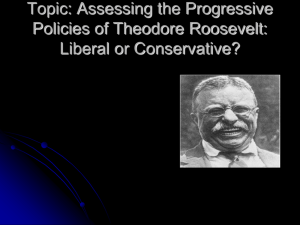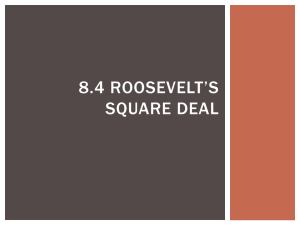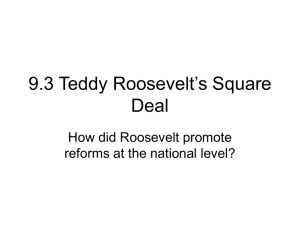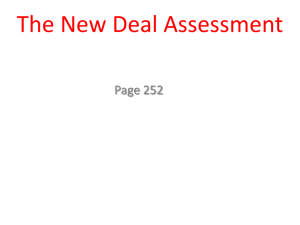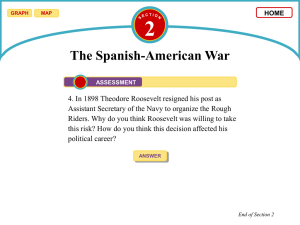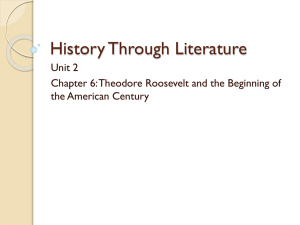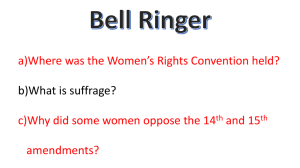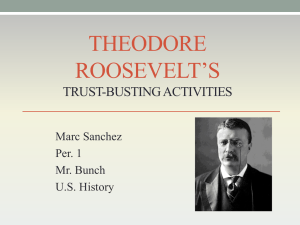Roosevelt`s Square Deal - Clovis Municipal Schools
advertisement
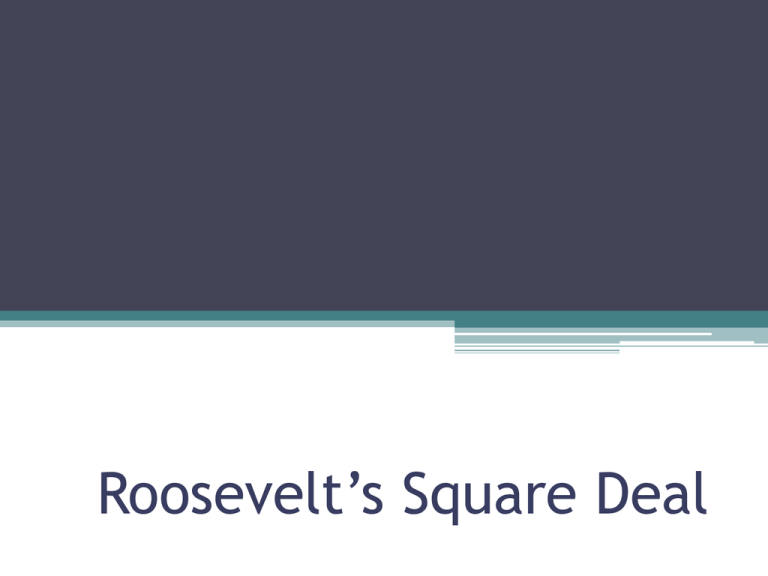
Roosevelt’s Square Deal Roosevelt Rises to the Presidency Graduate of Harvard Loved wildlife Named Assistant Secretary of the Navy under President McKinley. Formed Rough Riders in Spanish American War. (Calvary Unit) Elected Governor of N.Y. Progressive beliefs Vice President under McKinley and became President when he was assassinated • Teddy Bear named after him. • Square Deal=keep the wealthy from taking advantage of the poor and small business owners. Square Deal •TR believed in the “capitalistic system” but believed that the system must be regulated by US Govt. •TR was a Hamiltonian but for the betterment of the “common man” as opposed to benefit the elite. •TR believed the U.S. Government was running the country and not the rich and corrupt industrialists…. •U.S. Government involvement with “regulatory agencies”….Similar to “checks and balances” Square Deal •Reforms of the Progressives start with President Roosevelt…. •Areas which he wanted to reform and use the “bully pulpit” of the Presidency were the following: •Bad Trusts vs. Good Trusts •Take the side of labor •Railroads •Limiting corruption in the workplace •Conservation TR, the “Trustbuster” •Department of Labor •Bureau of Corporations •Filed more than 40 anti-trust suits using the Sherman Anti-Trust Act. •Northern Securities •Standard Oil •Swift Beef The Trustbuster Trust- Group of separate companies that are placed under the control of a single managing board in order to form a monopoly. Coal miners strike 1902- Threatens to send in federal troops to end strike. Federal government steps in for 1st time and helped workers in a labor dispute. Formed Department of Commerce and Labor Railroads Railroad Reforms to boost the Interstate Commerce Commission. •Elkins Act •Anti-Rebate Act or AntiKick Back Act •Regulates common carriers of people and freight, UPS, Greyhound, Amtrak, etc. •Hepburn Act •Regulates rates for passengers and freight •Air travel cost controls •Air freight price controls Enforces Sherman Anti-Trust Act Sherman Anti-Trust Act- banned any trust that restrained interstate trade or commerce. Broke up many trusts including Northern Securities Company (r.r. company) and beef trusts. Supported large corporations as long as they did business fairly. Regulating Food and Drug Industries Upton Sinclair - The Jungle Meat Inspection Act- Required federal agents to inspect meat that went across state lines and to inspect plants. Pure Food and Drug Act- Federal agents to inspect other foods and medicines and banned interstate shipment of impure food and the mislabeling of food and drugs. Today FDA (Food and Drug Adm.) enforces the law. •Reading The Jungle, TR brought about reform in proposing and signing into law the Meat Inspection Act, 1906 •All meat sold must inspected •Must be marked by Federal inspectors and graded. •Meat industry cleaned up. •Fish is regulated. •Pure Food and Drug Act, 1906 •Federal inspection to all packaged foods and drugs. •Labels with medicine as well as food. •Contents of food and drug packages must be listed •All additives/chemicals must be listed on labels. •FDA today or Food and Drug Administration TR’s Conservation Policy •125,000 acres in reserve •National Reclamation Act 1902 •25 water projects •Founding of the National Park System National Forests Conserved and preserved forests. Gifford Pinchot- Led Division of Forestry in U.S. Department of Agriculture. Idea that forest be preserved for public use. John Muir-Created Yosemite National Park in 1890. At this time they would preserve forests for logging, it later changed into public parks. •National Reclamation Act gave birth to the Newlands Irrigation Project. •Free land to Homesteaders who wanted to farm Lahontan Valley. •Dairy farming, hay, beef and sugar beets •Lake Lahontan and dam built in operation by 1914 Roosevelt Changes Water Policy Water was fought over in Southwest. Private irrigation companies were taking over riverbeds so farmers couldn’t reclaim lost land. National Reclamation Act 1902- Fed. Government decides where and how water could be distributed. Build and managed dams. Roosevelt and Hoover Dams on Colorado River. Salt Valley Project in Arizona. Taft Taft becomes president in 1908 Progressive but had some different ideas from Roosevelt. Payne-Aldrich Act 1909- Lowered tariffs but not as low as Roosevelt had wanted. Mann-Elkins Act 1910- Gave gov. control of telegraph and telephone rates. Dropped Roosevelt’s distinctions between good trusts and bad trusts. • Busted twice as many trusts as Roosevelt including Standard Oil Company. • Fired Gifford Pinchot for criticizing Richard Ballinger (Sec. of Interior) ▫ Ballinger opposed Roosevelt’s conservation policies, and sold federal land rich with coal deposits to Alaska. ▫ Ballinger-Pinchot Affair Roosevelt Strikes Back New Nationalism-Program to restore government’s trustbusting power. Declared himself as strong as a bull-moose. Bull-Moose Party- Progressives who were for Roosevelt for a 3rd term. Included Jane Addams. Republicans- Supported Taft. New Freedom Goal: • Favored an active role in economic and social affairs. • Favored small businesses and the free functioning and unregulated and unmonopolized markets. • Tackle the “triple wall of privilege”: the tariff, the banks, and the trusts. 1. Similar to Roosevelt’s New Nationalism. New Nationalism Goal: • • 1. 2. 3. 4. 5. 6. 7. 8. Continuation of his Square Deal which were reforms to help the common man. Favored a more active govt role in economic and social affairs. Good trusts vs. bad trusts Direct election of senators Tariff reduction Presidential primaries Regulation of monopolies End child labor Initiative and referendum Women’s suffrage
